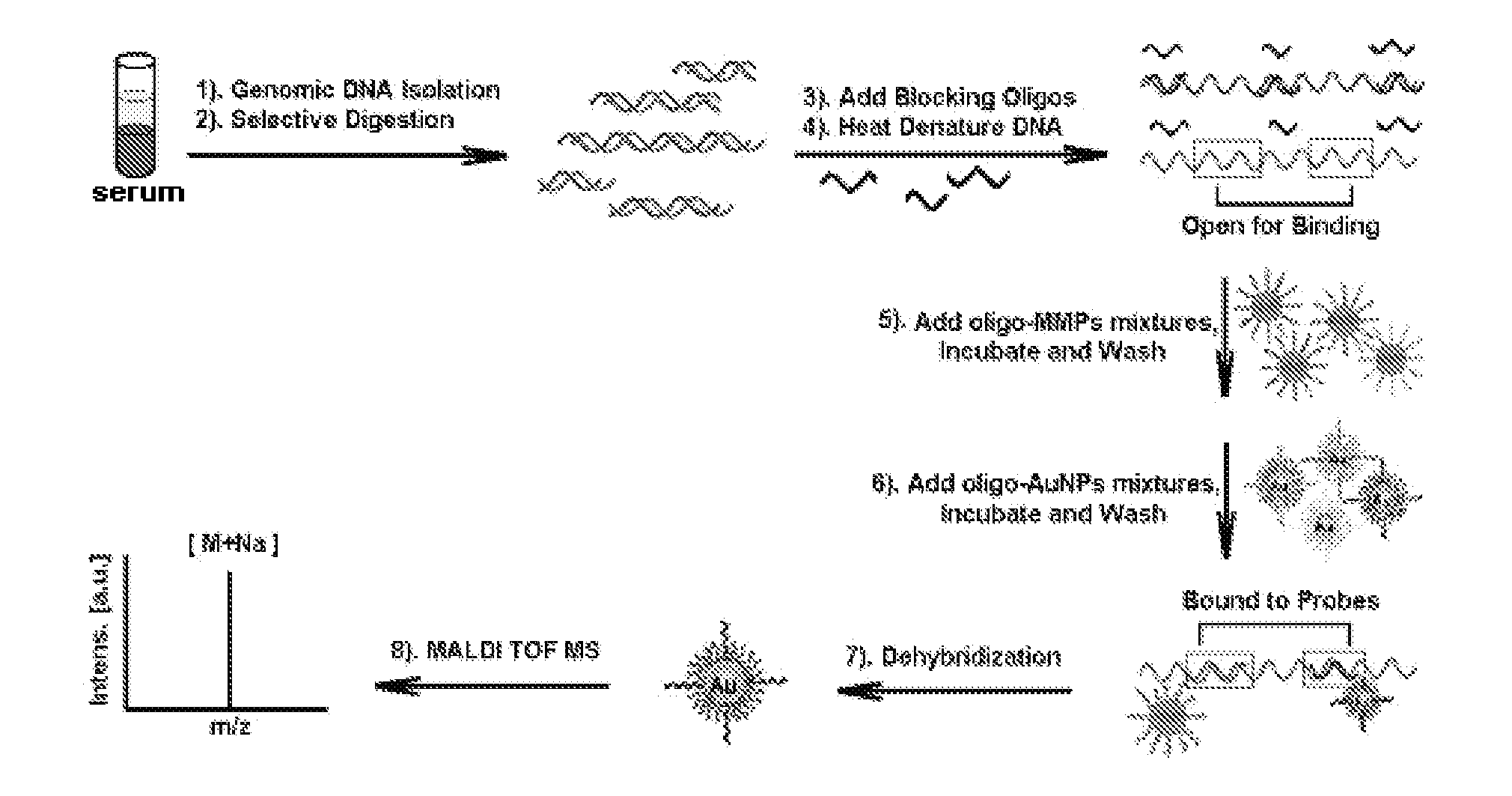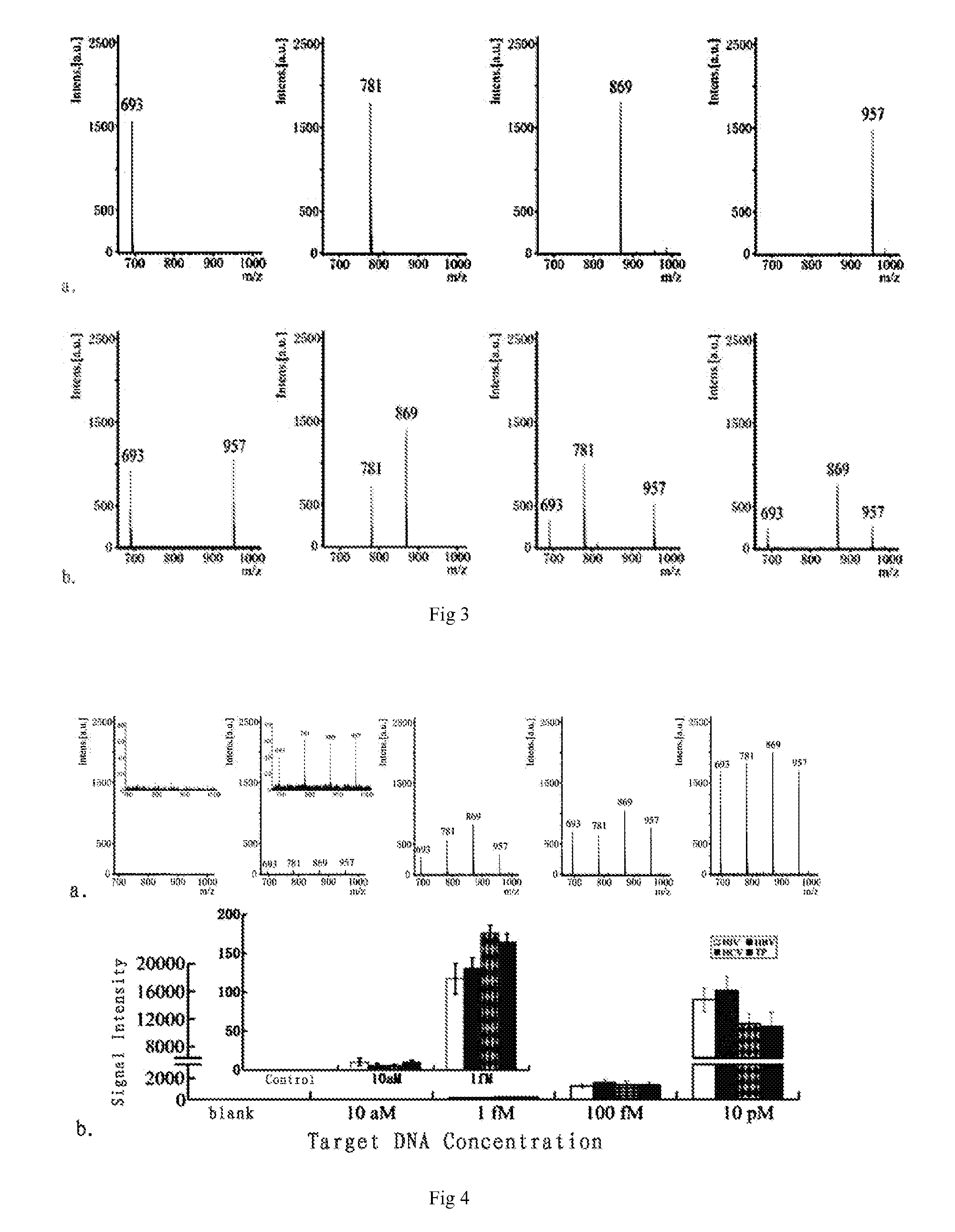Gene detecting methods without using PCR
a gene detection and gene technology, applied in the field of molecular diagnostics, can solve the problems of modern science and technology not being able to control and treat liver cancer well, being susceptible to pollution, and unable to effectively detect genes, etc., to achieve the effect of eliminating the need for pcr amplification, amplifying the signal of the target, and high sensitivity
- Summary
- Abstract
- Description
- Claims
- Application Information
AI Technical Summary
Benefits of technology
Problems solved by technology
Method used
Image
Examples
embodiment 1
The Application of Bio-Magnetic Nanoprobes in the Detection of HCV-DNA
(1) The preparation of HCV-AuNPs
[0053]① Took about 35 μg 1 OD HCV-DNA recognition molecules (5′GCA GTA CCA CAA GCC AAA AAA AAA A SH 3, SEQ ID NO. 1), centrifuged 5 minutes (5000 rpm), then dissolved with the add of 200 μL ultra-pure water, vortexed 30 seconds, mixed evenly;
[0054]② Added 2 mL of colloid gold (synthesized by ourselves, 13 nm, determined by transmission electron microscopy), kept shaking softly for 24 hours (20 rpm), at room temperature (25′C).
[0055]③ Added phosphoric acid buffer solution 1 (0.3M NaCl, 10 mM phosphoric acid buffer solution (PBS), pH=7.0), made the NaCl concentration of the system to 0.1 M, kept shaking softly and aging for 36 hours;
[0056]④ Added 48 μL pentaethylene glycol disulfate (with 100 mM ethanol as its dissolvent), kept shaking softly for 12 hours, and the colloidal gold-nanoprobes with the proportions of recognition molecules and encoding molecules of 1600:1 can be obtained. ...
embodiment 2
Multiplex Assay Based on the Mixed Solution of Bio-Magnetic Nanoprobes Target DNA (HIV, HBV, HCV and TP)
[0063]The sequences of DNA strands involved in this embodiment were shown in table 1:
[0064]
TABLE 1Sequence NameNameSequenceSEQ ID NO. 5HIV-AuNP5′-GCT GTC CCT GTA ATA AAC CCG AAA ATT TTTTTT TT-(CH2)3-SH-3′SEQ ID NO. 6HbV-AuNP5′-CTC TGT GGT ATT GTG AGG ATT CTT GTC ATTTTT TTT TT-(CH2)3-SH-3′SEQ ID NO. 7HCV-AuNP5′-CGC TTT CTG CGT GAA GAC AGT AGT TTT TTTTTT TT-(CH2)3-SH-3′SEQ ID NO. 8TP-AuNP5′-GTG TAC TAG CCC TCC CTT CTA CCT GAT TTTTTT TTT-(CH2)3-SH-3′SEQ ID NO. 9HIV-MMP5′-SH-(CH2)6-TTT TTT TTT TTT GTA TGT CTGTTG CTA TTA TGT CTA TTA TTC TTT CCC CTG C-3′SEQ ID NO. 10HBV-MMP5′-SH-(CH2)6-TTT TTT TTT TCA AAC GGG CAACAT ACC TTG GTA GTC CAG AA-3′SEQ ID NO. 11HCV-MMP5′-SH-(CH2)6-TTT TTT TTT TCG CAA GCA CCCTAT CAG GCA GTA CCA CAA-3′SEQ ID NO. 12TP-MMP5′-SH-(CH2)6-TTT TTT TTT TTT TGT AAT GTATCG TTT GTT GCT TCT GTA TCT ATT TCT TGC-3′SEQ ID NO. 13Passivated5′-SH-(CH2)6-TTTTTTTTTT-3′DNASEQ ID NO. ...
embodiment 3
The Detection Biological Sample
[0078]HBV genome DNA is double-stranded covalently closed circular DNA. There have been reports showed that the key step of the detection of real biological samples is the use of inhibitory oligonucleotide chain (blocker) in the heat denaturation process of double-stranded DNA, to improve the hybridization efficiency of one of the single—chains and the probes. Because these inhibitory oligonucleotides can effectively prevent the renaturation of two single-stranded. DNAs during the cooling process, or prevent the formation of supercoiling structure of single-stranded DNA, so they can improve the hybridization efficiency of the probes. We adopted this method in this embodiment (see FIG. 5) to improve the hybridization efficiency, and multiplex assay of embodiment 2. And the detection limit of real biological samples can reach 10−15M.
3.1 The Detection of Biological Samples of Hepatitis B Patients
[0079]In this experiment the sequences of inhibitory oligonu...
PUM
| Property | Measurement | Unit |
|---|---|---|
| particle size | aaaaa | aaaaa |
| size | aaaaa | aaaaa |
| wavelength | aaaaa | aaaaa |
Abstract
Description
Claims
Application Information
 Login to View More
Login to View More - R&D
- Intellectual Property
- Life Sciences
- Materials
- Tech Scout
- Unparalleled Data Quality
- Higher Quality Content
- 60% Fewer Hallucinations
Browse by: Latest US Patents, China's latest patents, Technical Efficacy Thesaurus, Application Domain, Technology Topic, Popular Technical Reports.
© 2025 PatSnap. All rights reserved.Legal|Privacy policy|Modern Slavery Act Transparency Statement|Sitemap|About US| Contact US: help@patsnap.com



